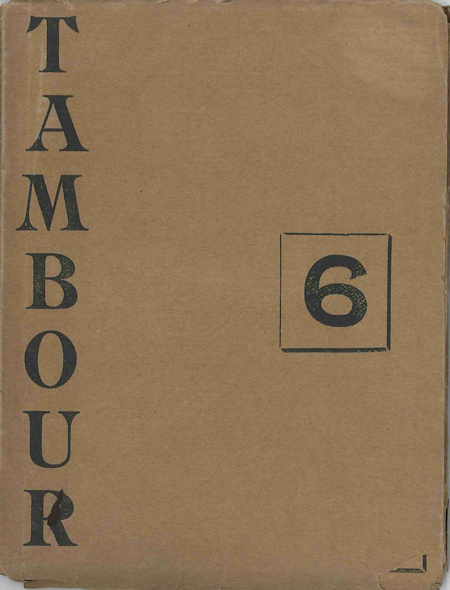
Title:
Tambour
Date of Publication:
Nov. 1928 – June 1930
Place of Publication:
Paris, France
Frequency of Publication:
Quarterly
Circulation:
Around 2,000
Publisher:
Howard J. Salemson
Physical Description:
Irregular pages. 5.5″ x 6.5”: 60 pages of texts and notes followed by advertisements.
Price:
Unknown
Editor(s):
Howard J. Salemson
Associate Editor(s):
Unknown
Libraries with Original Issues:
Unknown
Reprint Editions:
Salemson, Howard, ed. Tambour. Comp. Mark S. Morrison and Jack Selzer. Vol. 1-8. Madison: University of Wisconsin, 2002. Print.
Tambour ran from the end of 1928 until June of 1930. The magazine was under the sole direction of its editor and founder, Howard Salemson. Salemson created a “vigorous hybrid, combining the modernist little magazine’s emphasis on innovative and unknown authors with the revue genre’s emphasis on a wide-ranging review section at the end of each issue” (Morrison 20). With his goals for a hybrid publication, Salemson also aimed to bring Tambour to a multi-cultural audience. He wished to create a dialogue between French and American expatriate audiences and beyond “what could be achieved by occasional publication of foreign work in translation” (21).
Salemson reached multi-cultural audiences by including texts in both their original French and in English translation (that Salemson translated himself). The body of texts he published also included “early work of American writers who went on to enjoy great success,” including the work of writers like Paul Bowles and James T. Farrell (25).
Though Salemson only published 8 issues of Tambour, its run produced a sizable list of paid subscribers and its circulation grew to be larger “than those of other, more famous, little magazines like the Egoist” (58). Among Tambour’s subscribers were writers, philosophers, composers, moviemakers (sic), editors, and journalists from France, Italy, and the United States (59).
Tambour’s manifesto is provided at the beginning of its first issue and goes under the heading, “Presentation.” It was written by editor Harold Salemson and is provided in both French and English.
“To interpret the past is to express the present; to express the present is to create the future.
Every form of artistic expression, past, present, or future, whatever be its tendency, is tolerable. It is only by establishing the movement, forward or backward, of art, that we can bring out its meaning, its value. The new direction can be conceived only in the light of the lessons learned of the past.
In questions of art or of literature, ideas, beliefs, races, all melt into one. Whatever may be our origin or our convictions, we are all humans united in an overpowering search for the ultimate goal of art, beauty.
We shall assemble all the species, all the tendencies. To our readers will be left the privilege of passing judgment.
BUT THE NEW GAIT WILL BE SOUNDED TO THE BEAT OF THE TAMBOUR.
H.J.S.”
Howard J. Salemson (1910 – ?)
Editor: 1928 – 1930
Howard J. Salemson was the editor of Tambour and exercised complete control over the magazine. Born in Chicago in 1910 as the son of a physician and teacher, Salemson was 18 when he started editing Tambour. He enrolled in the Experimental College at the University of Wisconsin-Madison in 1927. By 1928 Salemson had acquired enough of a background in French that the Experimental College decided to support a new venture for Salemson in Paris in the form of a little magazine. In 1928, with the funding of the Experimental College, Salemson published the first issue of the French literary magazine, Tambour (Morrison 6) .
After the conclusion of Tambour’s publication, Salemson kept his “bilingual emphasis” and began translating “articles and literary pieces for literary and film magazines, and also translated some twenty books–primarily nonfiction–from French into English” (66). Salemson also took his affinity for film and film criticism to the United States when he moved to Hollywood, CA with the intention of “becoming creatively involved in the making of films” (66). Due to the Great Depression, however, Salemson was never able to break into the film industry creatively. In the years following his 1931 move to Hollywood, Salemson worked for several major movie studios, but as “assistant director, technical advisor, French lyricst, and recording supervisor, publicity writer, and publicity director” (67).
Howard J Salemson (notable contributions)
“Presentation”
“Open Letter to Michael Gold”
“To A Group of Young Men.”
Julian Shapiro
“You Drum Major”
“An Old Lady”
Edward Roditi
“Melanchole Au Grand Air”
“Often At Night”
“Poems”
H.R. Hays
“A Necessary Dismissal”
Richard Thomas
“Vie Et Cevre de Jean Cocteau”
“Portrait of a Writer”
Hoffman, Frederick J., Charles Allan, and Carolyn F. Ulrich. The Little Magazine: A History and a Bibliography. 2nd ed. Princeton: Princeton UP, 1947.
Mark Morrisson, “Tambour, the ‘Revolution of the Word,’ and the Parisian Reception of Finnegans Wake,” in Mike Begnal (ed) Joyce and the City: The Significance of Place. Syracuse University Press, 2002.
Salemson, Howard, ed. Tambour. Comp. Mark S. Morrison and Jack Selzer. Vol. 1-8. Madison: University of Wisconsin, 2002. Print.
Scholes, Robert and Sean Latham. “Modernist Journals Project.” (n.d.): MLA International Bibliography. EBSCO. Web. 12 Sept. 2010.
“Tambour” compiled by Danny Weiss (Class of ‘11, Davidson College)